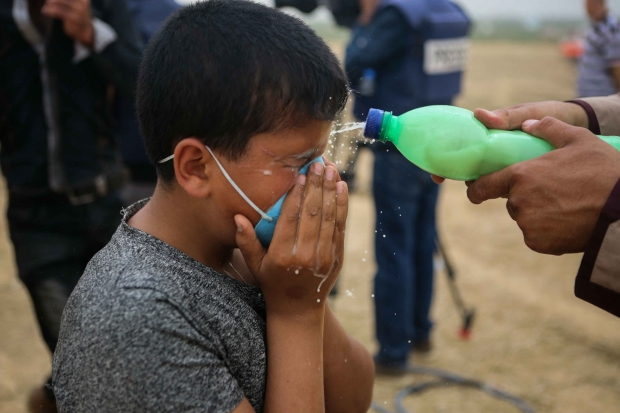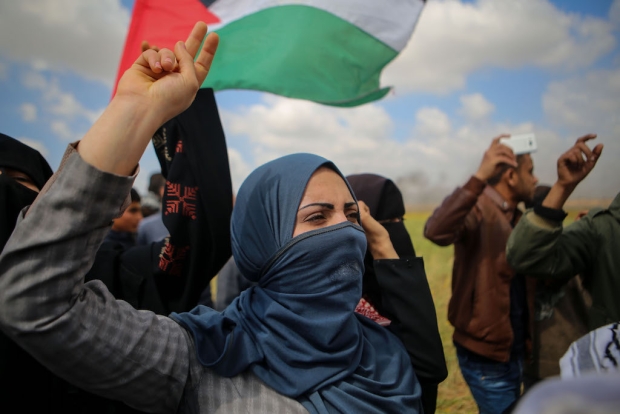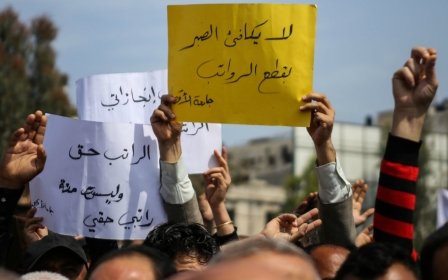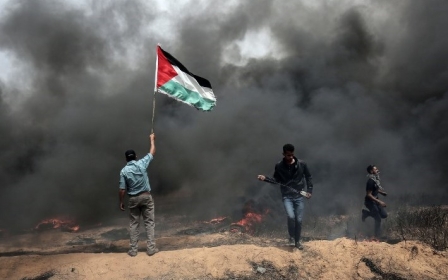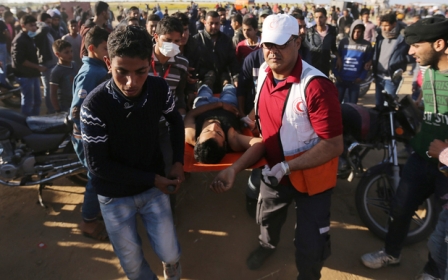Palestinian workers say Gaza 'Great March of Return' is their 'last hope'
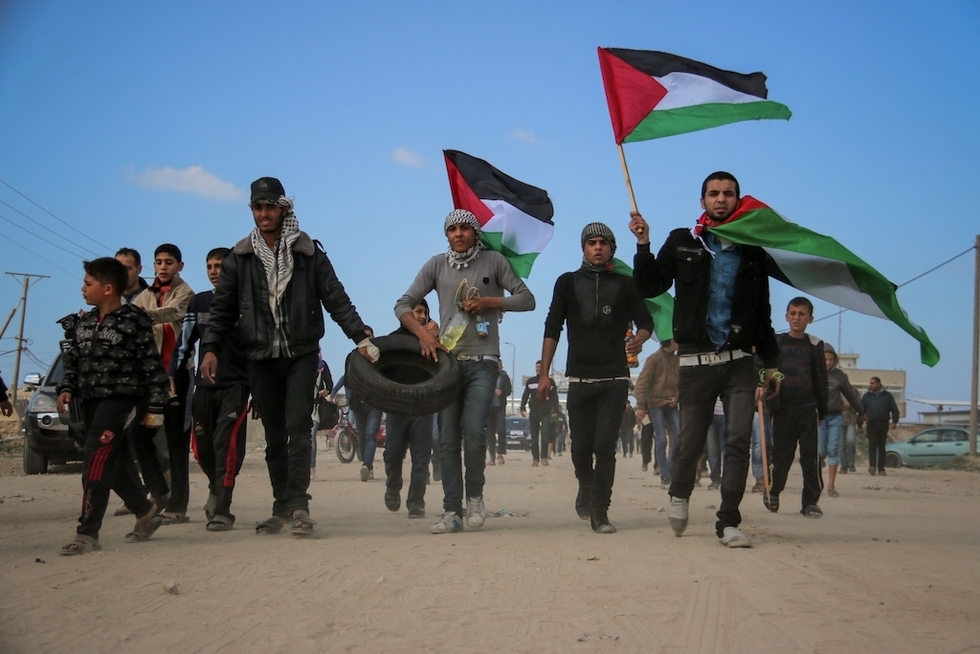
Palestinians headed into the sixth week of demonstrations as part of the “Great March of Return” on Friday, as protest organisers chose to highlight the plight of workers in the Gaza Strip.
Israeli forces stationed behind the fence separating Gaza from Israel were firing tear gas, rubber-coated steel bullets, and live ammunition at demonstrators protesting in several areas in the Strip, an MEE correspondent reported.
A Palestinian child was directly hit by a tear gas canister east of Khan Younis in southern Gaza, they added, and a protester was injured in the head after being hit by a canister near Jabaliya, in the northern Gaza Strip.
I see no hope in the Israeli occupation, as it kills us with no mercy, while we are unarmed and peacefully protesting
- Mansour al-Hattab, construction worker in Gaza
Several people were wounded by live fire across Gaza.
Meanwhile, three journalists were injured in Khan Younis - two who were hit by tear gas canisters, while another suffered from excessive tear gas inhalation. Photojournalist Sami Mosran was also reported to be wounded after being struck by a rubber-coated steel bullet while covering demonstrations east of al-Bureij refugee camp.
The Gaza ministry of health confirmed the journalists' injuries, adding that two ambulances had been targeted with tear gas east of Khuzaa in southern Gaza, while a medical tent in Rafah suffered a similar fate.
The ministry of health reported that at least 1143 Palestinians, including 36 minors, had been wounded as of 9pm local time. At least 70 people were injured after being shot with live bullets.
The ministry put out an urgent call for medical supplies, as the influx of wounded in the past several weeks has severely strained Gaza's medical infrastructure.
On Friday evening, Israeli and Palestinian media reports emerged, stating that some demonstrators had set infrastructure ablaze at the Kerem Shalom crossing - the only crossing through which Israel allows goods to enter the Gaza Strip.
Translation: An Israeli military outpost is burned by young people at Karam Abu Salem (the Arabic name for Kerem Shalom) in the southern Gaza Strip, after being stormed by a large number of protesters this evening.
A focus on unemployment
Days after International Workers' Day, the march seeks to draw attention to the difficult economic conditions for Palestinians in Gaza where at least 43.6 percent of the population is unemployed according to the Palestinian Central Bureau of Statistics, and about 80 percent of the population is dependent on foreign aid to survive.
Palestinian Authority (PA) civil servants in the Gaza Strip have also suffered from repeated salary delays and cuts, as their importance for the besieged Palestinian territory’s economy is apparently used by the PA as a pressure point to target Hamas.
Israeli army Arabic spokesman Avichay Adraee derided this Friday's theme, editing images on social media to read "Friday of Palestine's ignorance" instead of "Friday of Palestine's workers".
Translation: You are calling this Friday, the Friday of Palestine’s workers, while Palestinian workers in Gaza suffer from the worst conditions because of the injustice and arrogance of Hamas. Do not lie to yourselves, and start working for your future.
But demonstrators rejected Adraee's claims, pointing out that Israel's nearly 11-year blockade of the Gaza Strip has had a devastating effect on the small territory's economy.
“I used to supervise 10 workers, and today I cannot find a job opportunity,” unemployed carpenter Amin Herzallah, 40, told Middle East Eye.
“The Palestinian workers never stop giving, they contribute in building society regardless of the Israeli occupation and wars,” Herzallah added. “However, we do not enjoy our full rights in Gaza due to the limited job opportunities, the collapsed economy, and the occupation that prevent many materials and equipment from entering Gaza, which hinder us from working and earning our income."
“We see the Great Return March as our last hope,” 32-year-old Mansour al-Hattab told MEE. The construction worker has been out of a job for eight months, and has depended on humanitarian aid for the survival of his four children - income that has dried up in the past several months due to decreased funds.
“I see no hope in the Israeli occupation, as it kills us with no mercy, while we are unarmed and peacefully protesting. We call the international world to take actions towards the situation of the workers and Israel’s crimes against us.”
An Israeli military spokeswoman told AFP that some of the protesters threw stones in the direction of Israeli forces.
The army also said there was an attempt to "sabotage the security fence and to infiltrate into Israel".
During the events, two army drones crashed in the Gaza Strip. "The matter is being looked into", a statement from the army said.
Israeli media have in recent days reported significant damage to farms due to kite-flown Molotov cocktails from Gaza, though the devices face difficult odds in making it across the fence while still lit.
News outlets have also reported Israeli army claims that some kites flying from Gaza over the security fences carried explosives - allegations demonstrators denied.
“The Israeli occupation views the kites as source of danger, as they reached the Israeli farms and caused fire in large areas,” Munir, a 23-year-old demonstrator who wore a mask to avoid being identified by Israeli forces, told MEE. “But we do not have any explosive materials.
“The occupation wants to exaggerate the issue. The kite fires can be easily extinguished with a bottle of water, but the occupation wants to deviate the international world support from our peaceful struggle by spreading lies.”
Israel continues to shake off calls for independent investigation
According to the Gaza Ministry of Health, the number of Palestinians killed by Israeli forces during demonstrations in Gaza since 30 March reached 45 on Thursday, after 19-year-old Anas Abu Aser succumbed to wounds sustained a week earlier.
More than 7,200 Palestinians have been wounded during the demonstrations.
The AFP news agency reported that another four Palestinians had been killed during the same time period, outside of the scope of the protests.
According to Palestinian rights organisation al-Haq, at least 26 journalists have been injured by Israeli forces while covering the demonstrations, as rights groups have denounced the targeting of reporters and paramedics.
No Israelis have been injured.
The Israeli army's use of live fire during the protests has drawn international criticism and calls for an independent probe - which Israel has rejected.
A number of human rights and legal organisations petitioned the Israeli Supreme Court in April to challenge the Israeli army’s use of live fire against demonstrators in Gaza. The Supreme Court gave the army and petitioning parties until 6 May to file additional materials.
“The army tells the court that it tries to learn its lesson from what happens each week, but the casualties are still happening, and live fire is still being used by the Israeli army according to updates from today,” Suhad Bishara, a lawyer for Adalah, told MEE on Friday.
“We think there is no justification to use any live ammunition at all against the unarmed demonstrators.”
The six-week “Great March of Return”, which began on Palestinian Land Day, is set to end on 15 May - the 70th anniversary of the Palestinian Nakba (Catastrophe), in which more than 750,000 Palestinians were forcibly displaced by Israeli forces during the 1948 war between Israel and surrounding Arab states.
Demonstrators have been gathering every day several hundred metres from the fence separating Israel from Gaza, where almost 1.3 million of the small territory’s two million inhabitants are refugees, to demand the right to return to their pre-1948 homes.
Reporting on the ground in Gaza by Amjad Ayman.
New MEE newsletter: Jerusalem Dispatch
Sign up to get the latest insights and analysis on Israel-Palestine, alongside Turkey Unpacked and other MEE newsletters
Middle East Eye delivers independent and unrivalled coverage and analysis of the Middle East, North Africa and beyond. To learn more about republishing this content and the associated fees, please fill out this form. More about MEE can be found here.


